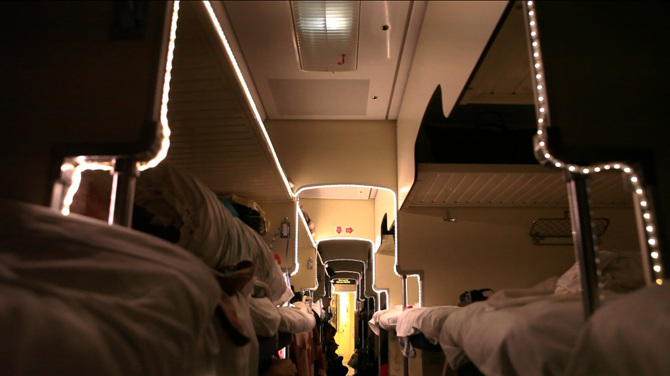Cyland Foundation Inc.
ARE PROUD TO PRESENT:
AT THE NEW YEAR
in the LUDA Gallery, St Petersburg, Russia
DECEMBER 29, 2014 – JANUARY 14, 2015

Mokhovaya 42, St Petersburg, Russia
+ 7 999 034 60 99
+ 7 911 968 64 84
AT THE NEW YEAR
The final project of the year by the LYUDA gallery features a video installation titled “Into the New Year” by Moscow artist Nastya Kuzmina. This three-channel projection reconstructs a celebration that Nastya organized on New Year’s Eve for passengers in a sleeper carriage of a Moscow-St. Petersburg train. The gallery was transformed to resemble a train carriage, with LED strips on the floor and walls mimicking the festive twinkling in the film. For Nastya, working with space is crucial, and it was of primary importance during the preparation process.“Into the New Year” is the graduation project of the artist, who completed her studies at the Rodchenko School this year. Initially, she thought of the carriage space itself as a form of regularity and rhythm, striving to emphasize it. However, the idea of the installation gradually transformed into a complete action, a situation.
The film’s plot is quite simple. Passengers enter the carriage, take their seats, unaware of what’s to come, and then the “miracle” begins. A golden carpet rolls out, a festively dressed girl walks through the carriage and magically lights up the bulbs, a singing trolley with tangerines passes by, and there are serpentine and sparklers everywhere. The shocked passengers first admire the attention and organization of Russian Railways (RZhD), but then realize that the “miracle” is only happening in their carriage, and start to figure out who organized it and why it’s being filmed. The initial wary impression quickly disappears, and the passengers get drawn into celebrating the New Year while on the move.
For Nastya Kuzmina, the train becomes an important metaphor. In Victor Pelevin’s novella “The Yellow Arrow,” the entire action takes place on a train, symbolizing life. Similarly, in the film “Into the New Year,” the train is chosen as an image of life, consisting of many periods of waiting between important events – births, weddings, meetings – bright flashes upon which our lives are built. The train represents that very waiting, a place where time and movement are felt most acutely, yet forcing one to come to terms with them. Nastya’s project is primarily about life, real life, despite the unreality of the events. Comparing her video to old Soviet films, where something impossible in real life always happens yet still fuels hope for a miracle, is not new. The artist is inspired by everyday life, finding new meanings in it to transform it and thus provoke unpredictable emotions and associations in participants and viewers.
The video “Into the New Year” is displayed as a three-channel projection. This approach is used to create an imitation of binocular and peripheral vision. If one walks from one end of the train to the other through all the carriages, one sees flashes of familiar everyday, yet often quite intimate images in the peripheral vision, while ahead is a series of doors leading to the very last one in the last carriage. Thus, the film is presented: the central screen shows the overall picture, the storyline, while the side screens show flickering secondary, but familiar everyday images. The LYUDA hall, with its geometry, is reminiscent of a carriage, and the elongated space dictates the conditions – the viewer becomes a character rushing through the carriage.
The observer is an important figure in Nastya Kuzmina’s works. In the case of the video project “Into the New Year,” it feels like the observers become everyone: both the passengers and the gallery visitors. But the participants of the “carriage” celebration also overcome difficulties, obstacles, basic shyness: “Don’t be shy, take a tangerine,” sings the trolley with tangerines. Watching the flashes of images are also ghosts in white sheets like from children’s tales, watching the passing trains. The fairy-tale sparkling ghosts of everyday life invite us to step out of the ordinary and believe in the incredible, even if it melts away in the morning. But, as the invisible loudspeaker in Pelevin’s “The Yellow Arrow” says: “The most important thing is the mood you step into the new morning with.”
“Into the New Year” is not pure documentation. Nastya was interested in showing the reactions and emotions of people, their surprise, bewilderment, and joy. The film is edited like a collage, and meanings are layered upon each other like a collage. A very simple idea in the spirit of video art pioneers opens up many new, unpredictable meanings. New Year’s in the Russian understanding is always the expectation of a miracle that never actually happens. New Year’s Eve is basically no different from other nights of the year, but Russians imbue it with almost pagan meaning. Nowhere in the world is this holiday awaited with such trepidation and anticipation. Nastya also emphasizes the “Russianness” of the train, its national character. Tea in glasses with cup holders, the rushing Russian expanses outside the window, sociable fellow travelers. You can recall many examples from Russian literature where the main character rides a train and plunges into deep thought or meets an unusual talkative companion. The fabulousness of Nastya’s film, its entertainment, imagery and literature once again revives in us the hope of a New Year’s miracle. It seems that the traditional night from the 31st to the 1st can now be not only a trip to the sauna and the subsequent flight in complete unconsciousness from Moscow to St. Petersburg, but also a holiday in a reserved carriage. And what could be more Russian than New Year’s Eve on the train?
Elizaveta Matveeva